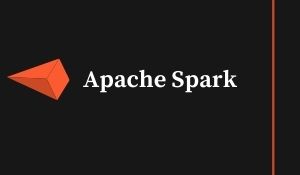
SPARK IN BRIEF:
Apache Spark is the third generation distributed data processing platform. It’s a unified big data solution for all bigdata processing problems such as batch, interacting, streaming processing. So it can ease many bigdata problems.
Spark is a lightning-fast cluster computing designed for quick computation. It was built on top of Hadoop MapReduce and it extends the MapReduce model to effectively use more kinds of computations which consists of Interactive Queries and Stream Processing. The primary feature of Spark is its in-memory cluster computing that will increase the processing speed of an application. Spark is designed to cover an extensive range of workloads such as batch applications, iterative algorithms, interactive queries and streaming. Apart from helping all these workloads in a respective system, it reduces the management burden of maintaining separate tools.

Apache Spark supports the following four languages: Scala, Java, Python and R. Among these languages, Scala and Python have interactive shells for Spark. The Scala shell can be accessed through ./bin/spark-shell and the Python shell through ./bin/pyspark. Scala is the most used among them because Spark is written in Scala and it is the most popularly used for Spark.
Benefits of Spark over Mapreduce:
Spark is really fast. As per their claims, it runs programs up to 100x faster than Hadoop MapReduce in memory, or 10x faster on disk. It aptly utilizes RAM to produce the faster results.
In map reduce paradigm, you write many Map-reduce tasks and then tie these tasks together using Oozie/shell script. This mechanism is very time consuming and the map-reduce task has heavy latency. And quite often, translating the output out of one MR job into the input of another MR job might require writing another code because Oozie may not suffice.
In Spark, you can basically do everything using a single application/console pyspark or scala console and get the results immediately. Switching between ‘Running something on cluster’ and ‘doing something locally’ is fairly easy and straightforward. This also leads to less context switch of the developer and more productivity. Spark kind of equals MapReduce and Oozie put together.
Limitations of Using Apache Spark:
- It doesn’t have a built-in file administration system. Hence, it needs to be integrated with other systems like Hadoop for benefitting from a file management system
- Higher latency but consequently, lower throughput
- No support for real real-time data stream processing. The live data streams are partitioned into batches in Apache Spark and after processing are again converted into batches. Hence, Spark Streaming is micro-batch processing and not certainly real-time data processing
- Lesser number of algorithms available
- Spark streaming doesn’t assist record-based window criteria
- The work wants to be distributed over multiple clusters instead of running the entirety on a single node
- While using Apache Spark for economical processing of big data, its ‘in-memory’ ability becomes a bottleneck.
LATEST UPDATES ON SPARK:
Apache Spark 3.0.0 is the first release of the 3.x line. This release is based on git tag v3.0.0.Apache Spark 3.0 builds on many of the innovations from Spark 2.x, bringing new ideas as well as continuing long-term projects that have been in development Spark SQL is the top active component in this release.
These enhancements benefit all the higher-level libraries, including structured streaming and MLlib, and higher level APIs, including SQL and Data Frames. Various related optimizations are added in this release. In TPC-DS 30TB benchmark, Spark 3.0 is roughly two times faster than Spark 2.4. Python is now the most widely used language on Spark. PySpark has greater than 5 million monthly downloads on PyPI, the Python Package Index. This launch improves its functionalities and usability, which include the pandas UDF API redesign with Python type hints, new pandas UDF types, and more Pythonic error handling.
Here are the feature highlights in Spark 3.0: adaptive query execution; dynamic partition pruning; ANSI SQL compliance; significant improvements in pandas APIs; new UI for structured streaming; up to 40x speedups for calling R user-defined functions; accelerator-aware scheduler; and SQL reference documentation.

CAREER OPPORTUNITIES:
As we know, big data analytics have a fresh new face, Apache Spark. Developers are leveraging the Spark framework in different languages. Such as Scala, Java, and Python. Basically, Apache Spark offers flexibility to run applications in their favorite languages. Also allows building new apps faster. Apache Spark is considered as a 3G for Big Data world. It offers in-memory data processing component that attends to real-time and batch actions. Moreover, it provides a flavor for the cloud business with or without Hadoop. Hence, there are some top-notch companies which are using Spark.
According to research Apache Spark has a market share of about 4.9%.The Spark’s significance and share are continuously increasing across organizations. Hence, there are ample career opportunities in spark. In addition, from Glassdoor, the median salary for big data expertise is $ 104,850 per annum. Also, a salary of data scientists is expected to be about $115,000. Moreover, according to Forbes, the median salary for big data professionals is $ 124,000 per year. Apache Spark Online Training will make your career a new height. We at Gologica’s provide you with an excellent platform to learn and explore the subject from industry experts.

